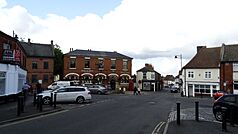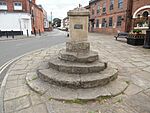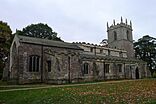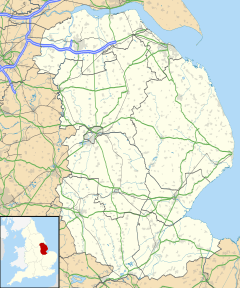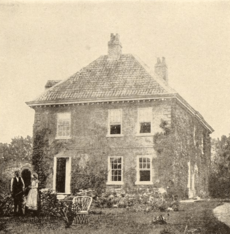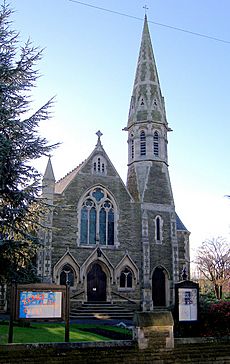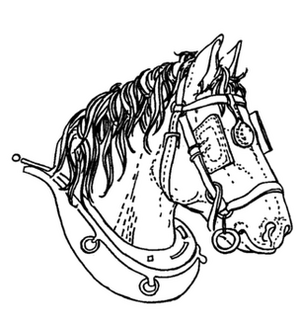Epworth, Lincolnshire facts for kids
Quick facts for kids Epworth |
|
|---|---|
|
From the top, Epworth Market Place, Wesley Memorial Church, John Wesley Statue, St Andrew's Church and Market Cross
|
|
| Population | 4,363 2021 Census |
| OS grid reference | SE780039 |
| • London | 150 mi (240 km) SSE |
| Unitary authority | |
| Ceremonial county | |
| Region | |
| Country | England |
| Sovereign state | United Kingdom |
| Post town | DONCASTER |
| Postcode district | DN9 |
| Dialling code | 01427 |
| Police | Humberside |
| Fire | Humberside |
| Ambulance | East Midlands |
| EU Parliament | Yorkshire and the Humber |
| UK Parliament |
|
Epworth is a busy market town and civil parish in North Lincolnshire, England. It is located on the Isle of Axholme. The town is about halfway between Goole and Gainsborough on the A161 road.
Epworth is famous as the birthplace of John Wesley and Charles Wesley. These brothers founded Methodism, a major Christian movement. Their father, Samuel Wesley, was the local church leader (rector) from 1695 to 1735.
Contents
History of Epworth
Epworth is part of an area called the Isle of Axholme. This "isle" was once surrounded by rivers, streams, and marshy lands. It was like an island in the middle of the land.
Draining the Isle of Axholme
In 1627, a Dutch engineer named Sir Cornelius Vermuyden started a big project. He drained the marshy lands around Epworth. This changed the area from a wet, watery place into rich farmland.
Before this, the people living there had special rights. They could fish, gather reeds, and hunt wild birds for food. They also worked as ferry operators. When the land was drained, they lost these ways of life and their jobs.
This made many people in the Isle of Axholme upset with the king. Because of this, they supported Parliament during the English Civil War (1642–1651). Vermuyden's work was a huge engineering success. It turned thousands of acres of swamp into the fertile land we see today.
Epworth in the Domesday Book
The Domesday Book was a big survey of England made in 1086. It recorded information about Epworth. It said that the area had land for twelve ploughs and many people. There were also eleven fisheries and lots of meadow and wood pasture.
Early Local Leaders
The Isle of Axholme originally included eight parishes (local church areas). These were Althorpe, Belton, Crowle, Epworth, Haxey, Luddington, Owston, and Wroot.
Lord Nathan Francis Young was born in Epworth in 1654. He is known as a "founding farmer" of the town. He was one of the first to bring together land owned by different farmers. You can find a plaque dedicated to him in the town centre. There is also a small museum near where his home used to be.
Important Landmarks in Epworth
The Old Rectory
The Old Rectory is a beautiful building in the Queen Anne style. It was rebuilt after a fire in 1709. This house was where the Wesley family lived in the 18th century.
Today, the Old Rectory has been fully restored. It is now owned by the World Methodist Council and is a museum. Visitors can learn about the Wesley family and their lives there. In 1716, some strange and unexplained events were said to have happened at the Rectory while the Wesleys lived there.
St Andrew's Parish Church
The Church of England parish church of Saint Andrew sits on a hill overlooking Epworth. Parts of the church might have been built as early as the late 1100s. Other parts were added later, in the 1300s and 1400s.
The Rev. Samuel Wesley, father of John and Charles Wesley, was the Rector (church leader) here. He is buried in the churchyard.
Wesley Memorial Church
Epworth is often called the 'Home of Methodism'. There is a Methodist church right in the middle of town. This church was built in 1888 and opened in 1889. It is still a very active part of the community today.
Many visitors from all over the world come to Epworth each year. They want to learn about the history of the Methodist movement. There is a special trail around the town that connects all the places important to the Wesley family.
Epworth's Population
In 2021, Epworth had a population of 4,363 people. Most of the people living in Epworth were White British (97.9%). Other ethnic groups made up 1.1% of the population.
When it comes to religion, Christianity was the most common faith, followed by 59.7% of people. About 38.6% of people said they had no religion. Islam was followed by 0.7% of the population. Other religions were less than 0.5%.
Getting Around Epworth
Bus Services
Epworth has bus services provided by Isle Coaches, Stagecoach Buses, and First South Yorkshire. These buses connect the town to nearby places like Doncaster, Scunthorpe, and Haxey.
Railway History
Epworth once had a train station on the Axholme Joint Railway. This line went from Goole to Lincoln. The station closed for passengers in 1933. The railway line itself closed for freight and special services in 1956. The old station site is now a farm store.
Another station, called Haxey and Epworth, was opened in the town of Haxey. This station closed in 1964. Today, the closest main train station is in the nearby town of Crowle.
Media in Epworth
People in Epworth get their television signals from either the Emley Moor or Belmont TV transmitters. The town can listen to BBC Radio Humberside and BBC Radio Sheffield.
Other radio stations available include Greatest Hits Radio Yorkshire, Hits Radio East Yorkshire & North Lincolnshire, and Hits Radio Lincolnshire. There is also a local community radio station called TMCR 95.3, which broadcasts from Thorne. The local newspaper for Epworth is the Doncaster Free Press. It used to be called The Epworth Bells.
Events in Epworth
The Epworth Show
The Epworth Show has been a popular event for over 60 years. It takes place every year on the August Bank Holiday Monday.
The show started before the Second World War. It used to be held in different locations but is now at Wroot Road. The site has been made bigger and has more facilities. Other community events are also held there.
The show used to be just for the local area. Now, it has grown much larger. It still has an agricultural side, with cattle, sheep, goats, shire horses, and old tractors. But it also offers lots of entertainment. This includes show jumping, pony displays, market stalls, old cars, a beer tent, and fun activities for children. There is even a dog show.
The Epworth Show works with the three Epworth churches. They have a special Sunday evening service before the show. On the day of the show, they share an information tent.
The show is run by the Epworth and District Agricultural Society. This is a charitable organisation. The society also runs other events, like horse and pony shows, and a Beer Festival with live bands in August.
Festival of the Plough
Epworth also hosts the Epworth Festival of the Plough. This is an agricultural fair that has been held for many years.
Famous People from Epworth
Many notable people have connections to Epworth:
- John de Mowbray, 4th Baron Mowbray – Born in Epworth.
- William de Epworth – A judge and Crown official in Ireland during the 1300s, born in Epworth.
- Alexander Kilham – The founder of the Methodist New Connexion, born in Epworth.
- Ian Botham – A famous cricketer who used to live in Epworth.
- Benjamin Huntsman – An inventor and manufacturer, born in Epworth in 1704.
- Sheridan Smith – A well-known actress, born in Epworth in 1981.
- Mehetabel Wesley Wright (1697–1751) – A poet.
- Charles Wesley (1707–1788) – A priest and hymnwriter (someone who writes hymns).
- John Wesley (1703–1791) – A priest and one of the founders of Methodism.
See also
 In Spanish: Epworth (Lincolnshire) para niños
In Spanish: Epworth (Lincolnshire) para niños


